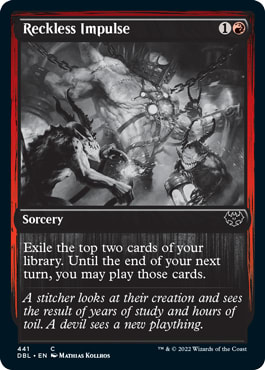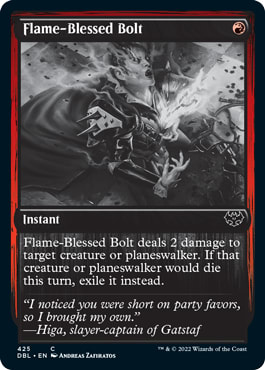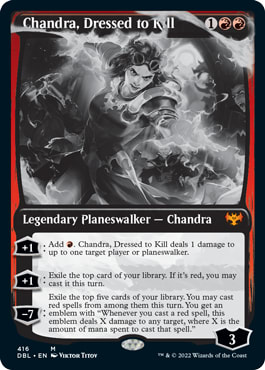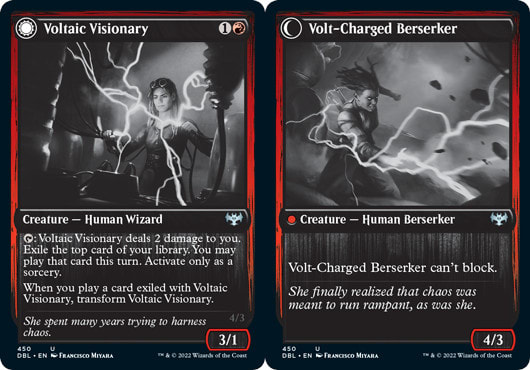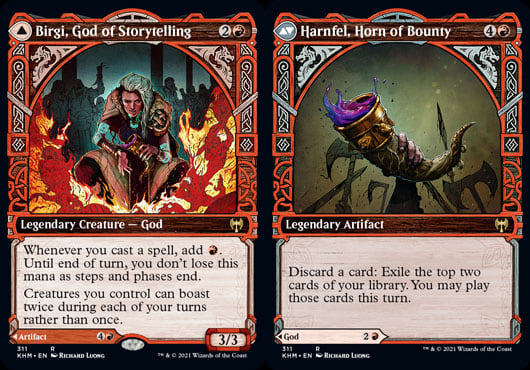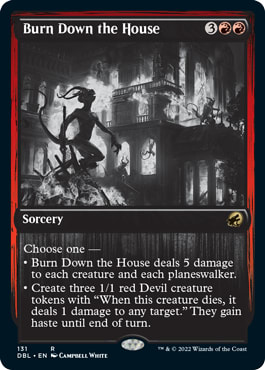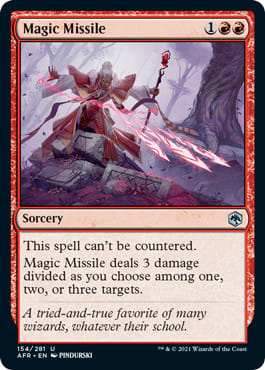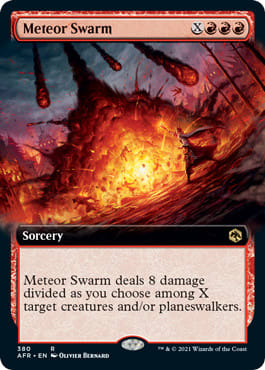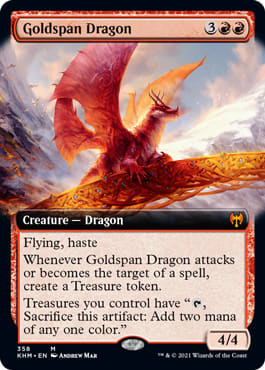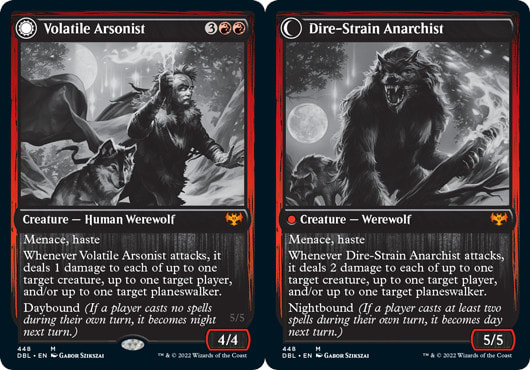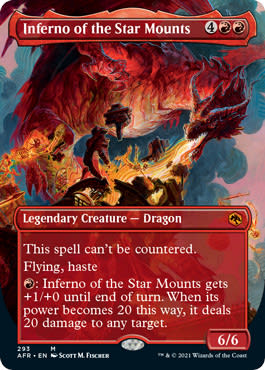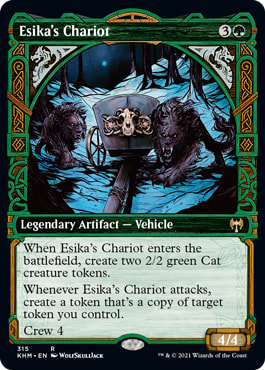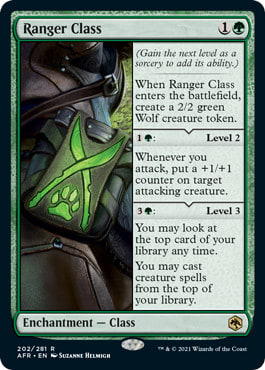In the last article, I talked about the White, Blue and Black cards from Strixhaven, Kaldheim, AFR, Midnight Hunt and Crimson Vow. Today, I'll be discussing the Red, Green and miscellaneous cards.
The context of evaluation is approximately for Singleton "legacy Cube" power levels. As a disclaimer, season to taste for card evaluation, as you'll know your Cube's metagame better than I if you feel that evaluations may differ from what I've said and because of that, adjust accordingly on your Cube's metagame.
Skip to:
Red
"The hits"
Falkenrath Pit Fighter - much like Usher of the Fallen, this is your bog-standard 2/1 for one, although I've never seen its ability used. But it's a 2/1 for 1, which is what the aggro decks want more of, at the end of the day.
Reckless Impulse as a "draw 2" is very powerful, although its consistency on being able to use both cards is reliant on the lowness of the aggro curves in your Cube, much like with Light up the Stage. The power level is quite high, and if your aggressive decks aren't currently built to take advantage of this, now's a great time to reconfigure.
Den of the Bugbear - the point about the creature lands from AFR continues to Den of the Bugbear and Lair of the Hydra, where they situationally enter untapped and are decent tools for providing some supplemental threats when flooded or after a wrath, but can mess with curving out. The Channel lands from Kamigawa: Neon Dynasty are another card that compete with the function of the creature lands, since they fill a similar role - being a land when needed and something else when you don't need a land. Judge accordingly, but lands are generally underrated and help contribute to winning games in a subtle way.
"Broad strokes"
Play with Fire, Flame-Blessed Bolt and End the Festivities are some cheap removal options which get better depending on how often drafters are playing low-to-the-ground threats. Play with Fire sticks out as an upgrade to an underrated classic (Shock) with an upside that helps aggro players when they need to make a killing blow. Frost Bite, as well as Skred, represent creature-killing options if you're looking to introduce (or re-introduce) snow basics into your land box.
Aggro Threats
Chandra, Dressed to Kill and Reckless Stormseeker // Storm-Charged Slasher are the highlights of "broad strokes" as cards that provide some board presence and immediate effect. Chandra's different than her usual iterations as more of a Sulfuric Vortex (that can, unfortunately, be attacked) or a draw engine, but Stormseeker's nice as well as a virtual 3/3 with haste, and outclassing others like Arni Brokenbow.
Voltaic Visionary // Volt-Charged Berserker, Birgi, God of Storytelling // Harnfel, Horn of Bounty, and Magda, Brazen Outlaw are amongst the better creatures in the rest of the tier of aggro threats - with Birgi having some utility for combo decks and a decent artifact side when flooding out. All of these also represent some form of reach, although Magda's usually doesn't happen unless the stars align very well (so it's more of a Goblin Piker meets Utopia Tree, in a mirror-imaged attacking role.)
Battle Cry Goblin, Cemetary Gatekeeper, Conspiracy Theorist, Dragonkin Berserker, Flame Channeler // Embodiment of Flame, Flameskull, Creepy Puppeteer, and Ill-Tempered Loner // Howlpack Avenger also can serve as creature filler for aggro curves. None of these are significantly better than what already exist, but some like Conspiracy Theorist can help with flooding out.
Voldaren Epicure, Hall Monitor, Goblin Javelineer and Kessig Wolfrider - fill the role of filler 1-drops to fill out early curves. None of these are incredibly powerful and, unless you're working with a Cube constraint (rarity, printing time restriction, etc), there's better options out there already, although Voldaren Epicure is better than it may look at first glance.
Slower Red Deck Things
Burn Down the House, Magic Missile, and Meteor Swarm are all mass-removal options for slower Red decks like midrange and control, although I'd personally prefer the ![]()
![]() cost of Arc Lightning and Flames of the Firebrand over the uncounterability text on Magic Missile. Burn Down the House is nice for having utility for Game 1 matchups where there aren't a lot of creatures. Meteor Swarm is the worst of these but an option to consider if needing another board wipe.
cost of Arc Lightning and Flames of the Firebrand over the uncounterability text on Magic Missile. Burn Down the House is nice for having utility for Game 1 matchups where there aren't a lot of creatures. Meteor Swarm is the worst of these but an option to consider if needing another board wipe.
Smoldering Egg// Ashmouth Dragon, Manaform Hellkite, Moonveil Regent, Zariel, Archduke of Avernus, and Stensia Uprising all represent mid-sized threats without haste that seek an answer from the opponent. They aren't necessarily better than the old guard of Hellrider and Flametongue Kavu, but cards like Moonveil Regent can also act as curve-toppers for aggro, if need be.
Unexpected Windfall is a miscellaneous card for the non-aggro decks and can help Red decks burst out a bunch of mana and cards for untapping and casting Titans (if that's a feature of your Cube), although the strength of Blue countermagic makes it dicey for maindeck inclusion.
Here Be Dragons (mid-cost hasty threats.)
Goldspan Dragon, Volatile Arsonist // Dire-Strain Anarchist and Inferno of Star Mounts all perform a similar role of being big beefy creatures with haste, to finish off opponents who've been beaten down in the early stages of the game. Goldspan is the best of these by having value if it gets targeted and/or gets in the Red zone, but they're all pretty interchangeable as top-end for aggro curves, if your aggro decks want a(nother) 5-drop.
If you have the Splinter Twin combo, your 5-drop spot in the curve is likely already stressed due to the real estate of Kiki-Jiki and Zealous Conscripts, but Goldspan may end up replacing an underpowering 6-7 drop, and that's an upgrade all-around.
Bloodthirsty Adversary is similar to Goblin Dark-Dwellers. Can be castable at two for aggro curves but this is mostly a 5-drop that can flash back small spells, and even flashing back a Bolt is fine (as there's usually at least some flavor of burn spell in the graveyard by the time that this can get kicked.) Extra kicker is gravy, if the game goes long too; can be a 2-drop to peck at walkers etc. if need be.
Green
"The hits"
Esika's Chariot may just be one of the best 4s for Green now, providing a ton of upfront power and removal protection as its power is spread across numerous permanents. Fits well as a midrange beefy threat and a curve-topper, if need be.
Ranger Class is somewhat similar as a card that acts as more of a equipment (if mana is put into it) and threat, although it's more a general jack-of-all-trades card. Putting mana into it lets it serve as somewhat of an Albino Troll variant that can grow, although the Class' staying power is mostly reliant on having threats on board that can attack, since the ultimate is so expensive, but if you're flooding out and on mostly creatures, it's a nice upside.
Jaspera Sentinel is another 1-drop accelerant that mana fixes. It's not as good as the one-mana ones that don't require another creature, but it's a nice addition to Green decks since acceleration and fixing help the Green midrange gameplan.
"Broad strokes"
Green Aggro
We've seen Green aggro take off in Standard; Green aggro's generally been a contentious topic in Cube, since Green has historically had ramp payoffs that people enjoy drafting and commonly associate with Green, whereas many people may not come into a Cube draft associating a 2/1 for 1 being in the mix (and if so, if it's a strategy worth pursuing.)
Cards like Ascendent Packleader, Deathbonnet Sprout // Deathbonnet Hulk, Snakeskin Veil and Werewolf Pack Leader fill out early action for Green aggro decks since the midrange decks generally aren't operating on the axis that these cards do. Blizzard Brawl represent a strong snow payoff in creature matchups and Old-Growth Troll acts as an honorary payoff due to its restrictive mana cost. Generally, supporting Green aggro comes at the cost of support at the higher mana end, so choose support accordingly. These cards don't really push Green into having a critical mass of support that it didn't have in 2020, but it can be an option to change things up.
Dragonsguard Elite, Masked Vandal, and Outland Liberator // Frenzied Trapbreaker are more generalist Green cards and Elite can grow into a 5/5 very quickly in a deck like Simic or Gruul with a lot of cheap magecraft cards. The other two help with artifacts and enchantments and are an example of cards that people tend to think of as "Cube cards", as Naturalizes tend to be historically more friendly to Cube than other formats because of the high power of individual artifacts.
Midrange Beef
On the other hand, Green got a lot of midrange beef that supports the 3+ mana value end of the spectrum. Some, like Realmwalker and Hamlet Vanguard are tribal support cards but the rest are general midrange threats:
Consuming Blob, Battle Mammoth and Froghemoth are 5-mana threats that are mostly reliant on them being not killed to be worth their mana cost, but can run away with the game if the opponent doesn't have the removal.
Augur of Autumn, Briarbridge Tracker, Cemetery Prowler, Primal Adversary and Ulvenwald Oddity // Ulvenwald Behemoth are similar midrange threats although a majority of these lean aggressive by having haste and having immediate impact, which helps Green midrange decks punch through control and attack opposing planeswalkers.
Wrenn and Seven, Avabruck Caretaker // Hollowhenge Huntmaster, Vorinclex, Monstrous Raider, Storm the Festival and Tovolar's Huntmaster // Tovolar's Packleader are, on the other hand, more classic midrange threats that provide a lot of value upfront through putting a lot of power on board (usually) but suffer against mass removal, which can exacerbate the midrange vs control matchup.
Miscellaneous
"The hits"
The bar for inclusion can get exacerbated by the amount of multicolored in your Cube, which can span from being a slim number to a lot of them buoyed by mana fixing like in Cubes like these!
Because of this, I'm going to adopt a similar "generalist" view to these multicolored cards, as multicolored cards comprise about 10-15% of a Cube list, although your section size may be different and that (in addition to general power level and/or themes) can adjust where your bar for inclusion lies. If so, adjust accordingly.
Faceless Haven - it's weird that the best snow payoffs are in this article as White, Blue and Black didn't have great snow payoffs. Faceless Haven is one of the better payoffs for having a bunch of basic lands in a deck by being a very strong on-rate attacker that can block (which is more relevant than one would think) and having 4 power ends games very fast. If you're looking to add a bunch of snow lands to your Cube, Faceless Haven, along with Icehide Golem, and Arcum's Astrolabe are some nice pickups - Frostwalk Bastion isn't bad as another payoff, but it's no Faceless Haven. On Thin Ice, Dead of Night, and Ice-Fang Coatl are some nice snow payoffs, too, even if the snow snake is fine without a single snow basic.
Valki, God of Lies // Tibalt, Cosmic Impostor is somewhat a Mono-Black card as a 2/1 for ![]()
![]() with a Peek attached (which is quite underrated a package) that can randomly disrupt an opponent that also has virtual kicker to be a tap-out threat that can take over the game if in a game state where there are few creatures to threaten him. I've been a fan of how well he plays across various matchups as even nabbing a midrange threat and turning Valki into it is more useful than one would think - and even better if you're cloning things like Titans which have strong attack triggers.
with a Peek attached (which is quite underrated a package) that can randomly disrupt an opponent that also has virtual kicker to be a tap-out threat that can take over the game if in a game state where there are few creatures to threaten him. I've been a fan of how well he plays across various matchups as even nabbing a midrange threat and turning Valki into it is more useful than one would think - and even better if you're cloning things like Titans which have strong attack triggers.
Vanishing Verse - great on rate and even if your Cube meta has more multicolored threats, I've found that this hardly lacks for targets and almost always hits something. Being instant is a huge bonus for a reactive spell, as a lot of catch-alls like Oblivion Rings are sorcery speed. Arguably the best multicolored card printed in 2021.
Expressive Iteration - speaking of pushed multicolored cards, depending on how lean your mana curves are in your Cube, Iteration may be the best card for izzet now outside of Inzerva (or arguably Dack Fayden, if there's a lot of artifacts to steal.) It's a fine turn three card to draw a card and ensure a land drop, and just gets better as the game goes on. It's a card that I'm generally happy to see in my Izzet decks or even my more greedy ones.
The Commands
Witherbloom Command has the most potential for upside as its power is mainly dependent on your metagame - its ability to nab small permanents (small mana rocks, things like Portable Hole, etc) and to bring back a land from the graveyard - although the Kamigawa: Neon Dynasty Channel lands will help to organically put land into the graveyard. The base mode is generally -3/-1 on a small creature, with the other modes being a secondary mode, but the addition of the Channel lands really do help make this a consistent performer in most Cube metagames.
Prismari Command emulates Kolaghan's Command well and Quandrix Command messes with combat incredibly well. Lorehold's and Silverquill command are the worst out of them as they're pretty expensive and situational but they're great when they hit.
Bloodtithe Harvester - this unassuming creature does a lot. It has an aggressive stat rate, can ping off small utility creatures (if the harvester lives) and the blood even helps to mitigate flood, which helps if you cast Harvester in later turns, to make sure that the outclassed body is still worth the mana cost, since you can just cash out a land for the hope of something better. Including it can also help to break up the Rakdos section being a pile of good multicolored removal options.
Rip Apart is another nice removal option, as, in addition to Naturalizes, cards that are "Downfalls" (creatures that kill creatures and planeswalkers) fit well into a Cube format by being able to attack opposing decks from another angle. Rip Apart does well by being a versatile card across a bevy of Cube matchups.
Blade Historian - a curve-topper for Mono-White, Mono-Red and Boros as something that isn't reliant on untapping, although it gets much worse if the opponent just kills it in combat, turning an alpha strike into a one-sided slaughter. Because of this, your removal suite determines how reliable he can turn combat into victories.
Arlinn, the Pack's Horde // Arlinn, the Moon's Fury and Halana and Alena, Partners - there's an old joke that all of the good Gruul cards cost four. It isn't too far from the truth, and these check off those same boxes. Both do a solid job of stabilizing the board, and can run away with the game if not dealt with, but Arlinn's wolf-generating ability helps to fight off spot removal. Both are fine additions to a Cube!
Torens, Fist of the Angels is Selesnya's take on Monastery Mentor, which plays to its strength of playing a boatload of bodies. Much like with Legion Warboss, Torens helps to train its buddies, which, in turn, also help train their buddies even if Torens dies (which Legion Warboss couldn't even do.) Selesnya has a glut of good on-rate cards like Qasali Pridemage, and this is one which actively rewards you for doing Selesnya things.
"Broad strokes"
I'm mentioning the pairs as "broad strokes" since, even though there aren't a lot of cards per pair, their impact can be high and can guide drafters towards drafting archetypes, if that's something you want to encourage or bolster in your Cube.
Blue-White
Dennick, Pious Apprentice // Dennick, Pious Apparition, Dorothea, Vengeful Victim // Dorothea's Retribution, The Raven's Warning and Monk Class - reward playing lower to the ground tempo strategies by being threats that are either cheap and/or reward you for casting cheap spells to remove potential blockers.
Faithful Mending, Niko Aris and Teferi, who Slows the Sunset align more with the tried-and-true Azorius control decks that tend to be featured in many Cubes, and Faithful Mending can dump large creatures into the graveyard for reanimating, if that's something Esper decks want to do, and can help to dump cards that are useless in Game 1 of a matchup. The mothership article previewing Teferi touches on his role in Cube as well:
But this encapsulates some of the issues that many Cube designers face with multicolored:
- None of the former category are overtly powerful enough to pull a Cube designer to give a strong enough payoff individually to pull their Azorius section to being more tempo-oriented (even Dennick, which has some strong stats on the front side and has a relevant ability to "flash back." Dennick was even given to me and my friend's Cube podcast!)
- The other cards are cards that could see maindeck play in a Cube (mainly Mending and Teferi) but may have a harder time breaking into a Cube itself because of the structure of multicolored and multicolored cards being naturally limiting in what decks can play them. Control tends to be able to utilize these types of cards better, since a Teferi (who Slows the Sunset, Hero of Dominaria, etc) isn't at its best on turn six, but is much better than a Dennick on turn six, and if it's being played in a tri-color deck, that may be when the stars align on when you're able to cast those.
Keep these in mind when looking at these multicolored cards and your multicolored sections.
Blue-Black
Siphon Insight, Xanathar, Guild Kingpin and Runo Stromkirk // Krothuss, Lord of the Deep - all lean toward a control direction, with Siphon Insight being the best of the bunch as a way to use unused interaction mana when the opponent doesn't do anything that you care about, or as action in slow mirrors, since it can hit lands and hitting your land drops is essential in those. The creatures are interchangeable with others but don't have much immediate impact or way to protect themselves and thus suffer as control creatures.
Black-Red
Rakdos' threats for broad strokes lean aggressive-midrange with Anje, Maid of Dishonor, Florian, Voldaren Scion, Immersturm Predator, Kalain, Reclusive Painter acting as beefy threats with some form of card advantage that can snowball if not dealt with. Orcus, Prince of Undeath and Olivia, Crimson Pride reward going for the long game and Orcus isn't bad as a flying Juggernaut if the board state calls for it, or as something to raise a ton of things from the dead if brought in for a matchup where you expect your early threats to die quickly.
Red-Green
Gruul's other cards are mostly mediocre, with Arni Slays the Troll and Kessig Naturalist // Lord of the Ulvenwald being some filler for aggressive-leaning midrange decks. Tovolar, Dire Overlord // Tovolar, the Midnight Scourge is just a werewolf card and Waking the Trolls is just way too overcosted as a disruption tool.
White-Green
Drizzt Do'Urden is similar to other "army in a can" type cards that we've seen, and cards like Tolsimir, Friend to Wolves do the job better.
Katilda, Dawnheart Prime and Sigarda, Champion of Light work to pull drafters towards humans as an archetype, if it's supported, as some strong payoffs to go wide, which the archetype wants to do anyway. Trelasarra, Moon Dancer also serves as lifegain payoff as well.
Black-White
Orzhov's 2021 cards are mainly midrange, with Edgar, Charmed Groom // Edgar Markov's Coffin, Extus, Oriq Overlord // Awaken the Blood Avatar, Kaya the Inexorable and Shadrix Silverquill as big midrange tap out threats with some form of inevitability tied into them, which helps to offset their 4+ mana costs. Fracture acts as a catch-all, but it may just be more of sideboard card, since so many other strong Orzhov cards like Vindicate and Vanishing Verse cut a much wider swath.
Blue-Red
Battle of Frost and Fire and Galazeth Prismari align with the usual Izzet control archetypes that like casting 2-for-1s and drowning the opponent out with instants like Electrolyze. Wandering Mind does as well and pecks away at planeswalkers as a decent threat or trades with small creatures.
On the other hand, Eruth, Tormented Prophet aligns with tempo strategies that seek to be able to cast multiple spells a turn (if Eruth reveals two spells) as a more proactive strategy, since she's a nombo with countermagic. Hitting a land + action spell is also fine for these more sleek Izzet decks but isn't great with your Izzet decks that would want to play Battle of Frost and Fire.
Green-Black
Golgari's cards mostly point toward midrange, with Sarulf, Realm Eater and Binding the Old Gods acting as removal options, even though they're not the most efficient at that role. Culling Ritual, like Witherbloom Command, gets much better if it's killing mana rocks and/or aggressive creatures, but gets much worse in matchups where its killing ability is uncertain.
Red-White
Showdown of the Skalds is another 4-cost curve topper for low-to-the-ground Boros decks (exactly how many your Cube needs is a question for your Cube, but it likely doesn't need another) and Hofri Ghostforge suffers moreso due to costing even more.
Sacred Fire is an odd take on Firebolt but isn't efficient enough to get there on rate and Fighter Class doesn't get there either at the moment, but it's something to keep an eye out on with Kamigawa: Neon Dynasty, as its reconfigure cards may help (although it still likely doesn't.)
Green-Blue
Quandrix Apprentice and Decisive Denial are able to be played in a myriad of Simic decks, but they're more at home in decks like tempo which leverage the body for attacking and (with Denial) fighting. Apprentice also helps by being able to ensure that you never miss a land drop, or have fuel to pitch to other cards, if that's a feature of your Cube.
Koma, Cosmos Serpent is a good example of a ramp target that can be worth the payoff, since it has resiliency and the timing window to kill it without getting something out of it (instant speed removal or exile) is pretty narrow. It's not bad to reanimate either, since its serpents can lock down lands.
Lastly, Minsc, Beloved Ranger is a nice mid-sized threat that resists removal. The hamster gets so much worse when Minsc dies (which makes sense, flavor-wise) but it's at least a consolation prize and it at least didn't cost 5-6 mana to cast.
I hope that you've enjoyed this romp through 2021's Standard-legal sets! Kamigawa: Neon Dynasty looks like it's going to be a great start to 2022 (although the supplemental set review of 2021 will be coming out!) Enjoy!
Check out my Linktree, with links to my Twitter and podcast here! - @Usmantherad | Linktree

















